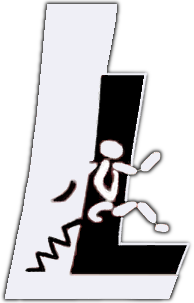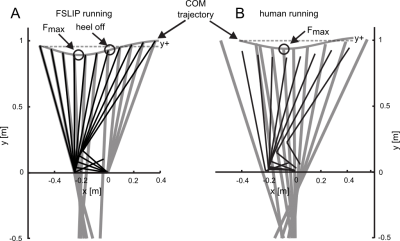Pick of the month
Compliant ankle function results in landing-take off asymmetry in legged locomotion.
The spring loaded inverted pendulum (SLIP) model is widely used to explain basic characteristics of human walking and running. Its periodic running solutions can be mirrored at the instant of the vertical orientation of the leg and thus are symmetric between landing and take-off. In contrast, human running shows asymmetries between touchdown and take-off (e.g. shorter brake than push duration, greater mean ground reaction force during braking phase). Yet it is not fully understood whether these asymmetries are caused by asymmetric muscle properties (e.g. velocity-dependent force generation) or the asymmetric lever arm system in the human leg. We extend the SLIP model by a foot segment and a compliant ankle joint (called FSLIP). This represents the extended foot contact and the displacement of the center of pressure during contact.
The FSLIP model shows the same asymmetries as found in human running without considering asymmetric muscle properties. Together with the reversed asymmetry observed in human backward running, this indicates that the asymmetric lever arms created by the foot can cause the observed landing-take-off asymmetry in human running.
Previous Picks
Pertubation Platform
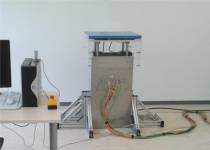 As often in Lauflabor, our hardware supplier Tetra (Tetra Ilmenau GmbH) has delivered a new piece of hardware. This time, it's a pertubation platform that can disturb human runners before, during and even after contact!
As often in Lauflabor, our hardware supplier Tetra (Tetra Ilmenau GmbH) has delivered a new piece of hardware. This time, it's a pertubation platform that can disturb human runners before, during and even after contact!
The core of this device is a force plate which is mounted on a vertical slider. The forceplate can move under load up to 1 m/s, with accelerations up to 4g. This allows to change the leg length and configuration under load, thus enabling new insights in the mechanisms that are responsible for creating the observed leg function.
Especially, it now becomes possible to investigate the long-standing hypothesis of an elastic leg: Elasticity implies a specific change of force as a function of length change. We can now directly investigate this in an experimental setup, and confirm or decline the widespread assumption of a dominant elasticity in the human leg behavior.
The BALANCE project has arrived

The EU founded BALANCE project aims at creating an exoskeleton that providesbalance support for humans. BALANCE, or more precisely B.A.L.A.N.C.E. is an acronym for Balance Augmentation in Locomotion, through Anticipative, Natural and Cooperative control of Exoskeletons.
There are four main fields of research in this project: Experiments with healthy subjects, biomechanical modelling, control design and hardware design of an improved exoskeleton.
At the Lauflabor, we will focus on biomechanical modelling in order to (a) understand how humans achieve and maintain balance in experiments, and (b) provide these models as basis for a control design to our project partners.
The BALANCE website is http://balance-fp7.eu
Our project partners are:
- Tecnalia Research & Innovation (Spain)
- Imperial College (UK)
- CEA-LIST (France)
- University of Twente (The Netherlands)
- ETH Zurich (Switzerland)
- Xsens (The Netherlands)
New technique for CoM calculation
In biomechanics, the motion of the centre of mass (CoM) is often topic of research and the accuracy of its estimation is crucial to the results. Typically, there are two ways to calculate the trajectory, namely integration of the ground reaction forces or using kinematic estimates from motion capturing. Both methods have their individual shortcomings.

Moritz Maus, André Seyfarth and Sten Grimmer have proposed a new method to combine data, that leads to physically consistent results, i.e. the outcome of the method are forces and a CoM motion, and the 2nd derivative of the motion times the mass is exactly the force. It combines those parts of the kinematic and dynamic measurements that are considered to be the most reliable. The algorithm is using different parts of the Fourier spectrum to overcome the inaccuracies of each measurement system.
In experiments and simulations, the authors show that the calculated motion and force very closely resemble the measured data. This closeness, together with the physical consistency, renders these data very reliable CoM estimates that can be used for further investigations with greater confidence.
- Literature
- Maus, H.-M., Seyfarth, A., and Grimmer, S. (2011). Combining forces and kinematics for calculating consistent centre of mass trajectories. J Exp Biol 214, 3511–3517. DOI:10.1242/jeb.057422
Stable Walking with Asymmetric Legs
Asymmetric leg function is often an undesired side-effect in artificial legged systems and may reflect functional deficits or variations in the mechanical construction. It can also be found in legged locomotion in humans and animals such as after an accident or in specific gait patterns. So far, it was not clear to what extent differences in the leg function of contralateral limbs can be tolerated during walking or running. Using a bipedal spring-mass model, Andreas Merker investigated the effect of asymmetries between contralateral legs on the dynamics and stability of spring-mass walking.
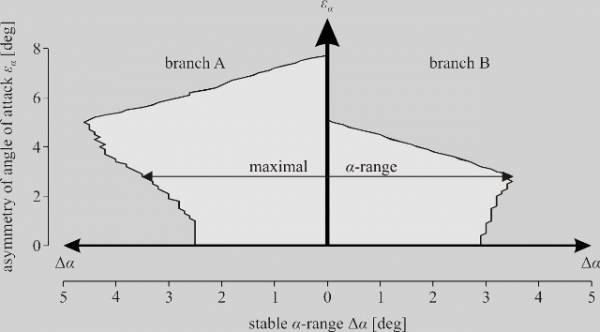
One important result of this study is that the asymmetric leg function does not necessarily reduce the region of stable walking. The asymmetry of leg angle can not only be tolerated during walking but it may also result in advantages, as demonstrated by the increased range of stable solution (figure). For a small range of values of leg angle, the asymmetry can even stabilize symmetric walking gaits.
- Literature
- Merker A, Rummel J, Seyfarth A. Stable Walking with Asymmetric Legs, Bioinspiration & Biomimetics, 6(4): 045004, 2011. DOI: 10.1088/1748-3182/6/4/045004
Quiet human stance is a dynamic multi-segment phenomenon
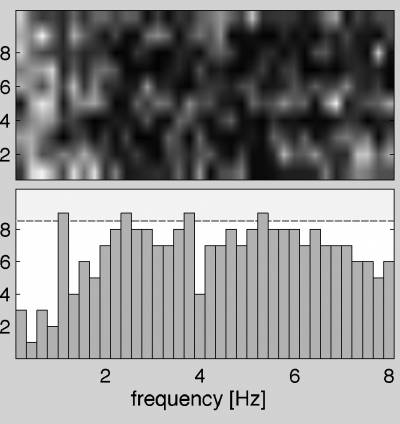
For many years, the postural research community analysed and discussed quiet human stance under the simplification of a single inverted pendulum model. While recent publications point more towards a multi-segment phenomenon distinguishing hip and ankle coupling, not much effort is spent in analysing knee contributions. From an anatomical point of view this is surprising, since biarticular muscles are spanning the knee joint and thus, mechanical coupling is evident for all joints of the leg.
Lab members Michael Günther and Sten Grimmer analysed kinematics and torques of quiet human stance for phase coupling of different joints. Hereto, in a close collaboration with computational neuro-scientists Lutz Leistritz and Peter Putsche, they used the phase synchronisation index (PSI) to separate couplings as a function of frequency.
One main result is that they did not find any synchronisation between ankle and hip across the whole frequency range examined up to 8 Hz. In contrast, there was significant synchronisation found between ankle and knee at a couple of frequencies between 1.25 Hz and 8 Hz when looking at the kinematics. The joint torques rather synchronise below 2 Hz.
The results clearly show that the knee is indispensable and biarticular muscles play a central role in organising quiet human stance.
- Literature
- Günther M, Putsche P, Leistritz, L and Grimmer S. Phase synchronisation of the three leg joints in quiet human stance. Gait and Posture (2011) vol. 33 (3) pp. 412-7. DOI:10.1016/j.gaitpost.2010.12.014
Studienstiftung workshop in Cologne
In the week from March 28th - April 1st, the last phase of a workshop for students from the german Studienstiftung des deutschen Volkes took place in Cologne. Here, students from different fields worked together on building walking robots of different kind: minimalistic actuated hexapods and quadrupeds (i.e. only a single motor) as well as a replication of the Runbot. All systems were set up with Lego Mindstorms, so that changes in the robot hardware could easily be done. Despite simple mechanical design of the robots, the robots showed a surprisingly well defined (i.e. repeatable) motion. Especially the Lego-version of Runbot could walk a large number of steps in a very dynamic manner. This workshop has once more demonstrated the fascination of creating walking machines based on simple biologically inspired design concepts.
Supervisors: André Seyfarth, Moritz Maus, Prof. Dr.-Ing. Johann Reger (TU Ilmenau)
Robustness or Efficiency
For designers of bipedal robots is the selection of leg parameters a major challenge. While the robot's target is clear (walking in a stable, robust, and efficient manner), it's difficult to find proper settings. Based on a theoretical study on walking with compliant legs Jürgen Rummel has shown that robustness is best at medium leg stiffness (10 < k < 20). This finding is important for robots with passive compliant legs where the inherent system dynamics have to be exploited.
Not surprisingly, the cost of transport decreases with increasing leg stiffness, and in the case of constant stiffness, the walker is more efficient at flatter angles of attack. Efficiency plays a substantial role for humans when walking on even ground because their leg stiffness is observed to be larger than 30. When the ground becomes slightly uneven, it can be assumed that their leg stiffness and angle of attack decrease in order to gain robustness.
- Literature
-
Rummel J, Blum Y, Seyfarth A. Robust and effcient walking with spring-like legs, Bioinspiration & Biomimetics, 5(4): 046004, 2010. DOI: 10.1088/1748-3182/5/4/046004
Rummel J, Blum Y, Maus HM, Rode C, Seyfarth A. Stable and robust walking with compliant legs, IEEE International Conference on Robotics and Automation, May 3-8, Anchorage, Alaska: 5250-5255, 2010. DOI: 10.1109/ROBOT.2010.5509500
Stable Running in Three Dimensions
Previously, it was shown that the spring-mass model of running in 2D comprises a self-stabilizing effect: The model is able to recover completely from perturbations. Frank Peuker shows that this self-stabilizing effect can also be observed in 3D if the leg is aligned appropriately during swing phase. Hereby, the common angle of attack is defined not in a world referential but in a body-oriented frame expressed by the velocity vector of the runners center of mass. This approach yields self-stable and symmetric running patterns. Further features include running at arbitrary low velocities, gait transitions from hopping to running and the emergence of large stability zones with splayed legs. These results suggest, that human-like locomotion could have evolved from splayed gaits which are less efficient but more robust.
- Literature
- Peuker F, Seyfarth A. Adjusting Legs for Stable Running in Three Dimensions, IFMBE Proceedings, Lim CT, Goh JCH (Eds.), Springer, 31(1): 3-6, 2010. DOI: 10.1007/978-3-642-14515-5_1
Concept for upright human gait
In human walking, the ground reaction forces are directed above the center of mass. This observation inspired Moritz Maus to establish a general concept for trunk stabilization. An hip actuator rotates the ground reaction force such that it intersects the body axis at one point above the center of mass. This concept translates the previously unstable inverted pendulum to a virtual pendulum, including its stabilizing feature. Experiments on chickens and dogs show a similar behaviour, hence, the erect posture in human ancestors did not provide a major mechanical challenge.
- Literature
-
Maus HM, Lipfert SW, Gross M, Rummel J, Seyfarth A. Upright human gait did not provide a major mechanical challenge for our ancestors, Nature Communications, 1, 70. DOI:10.1038/ncomms1073
Maus HM, Rummel J, Seyfarth A. Stable Upright Walking and Running using a simple Pendulum based Control Scheme, Advances in Mobile Robotics, Proceedings of 11th CLAWAR, Marques L, Almeida A, Tokhi MO, Virk GS (Eds.), World Scientific: 623-629, 2008. DOI:10.1142/9789812835772_0075
First robot demo of the Locomorph Group
In July 2010 the first robot demonstration, as part of the EU project Locomorph, was arranged in Jena. The demonstration was basically a test for the robot concepts. The robot evaluation was based on gait analyses, measurements of the cost of transport, and the walking performance on different surfaces and inclined planes. A novelty was that the setup for the gait analysis, which is normally used in the biomechanics lab, was applied for the small robots. Herefore, the motion was captured with a Qualisys high-speed camera system, and simultaneuosly the dynamics were measured with Kistler force platforms. Within the Locomorph project, the results of the robot evaluation are now part of a great discussion in order to find a concept for a new robot generation.
As a sattelite meeting the workshop Motion & Morphology took place, where latest developments on locomotion and morphological aspect were presented.
The workshop was a nice panel to collect new insights around gaits and adaptability in animals and humans. Invited speakers were Reinhard Blickhan, Koh Hosoda, Tony J. Presscott, Emanuel Andrada, Oskar von Stryk and Manfred Hild.
Press release: Internationales Forschungsprojekt präsentierte Laufroboter an der Universität Jena
How come a moving biped does not fall?
Variability is an inherent property of human locomotion. The ability of a moving biped to cope with variance in kinematic states resulting e.g. from mechanical imprecision relaxes design and control. This stochastic change in system parameters and states was not yet integrated into simple dynamic or kinematic models, thus the models exhibits periodic motion and traditional, mathematical stability measures could be utilised. Though there is a need for stability measures in human and robotic bipedal motion it is possible that these stability measures can not be applied due to variance masking periodic motion. Considering the required precision of mathematical models and the levels of mechanical, control and measurement variability it seems quite hard to find “stable” motion in robots or humans.
- Literature
- Renjewski D, Seyfarth A. How come a moving biped does not fall? US National Congress of Theoretical and Applied Mechanics (USNCTAM), June 27 - July 02, State College, Pennsylvalia, Paper number: USNCTAM2010-947, 2010.
Kinematic and dynamic similarities between walking and running
The extensive debate on whether or not amputee runner Oscar Pistorius would have a considerable advantage over able-bodied runners at the 2008 Olympic Games of Beijing put forth the concern that human technology has started to get the better of nature. However, prosthetic walking devices and robotic systems to date give no reason for a generalization of this concern.
There is a lack of generally accepted basic understanding of human gait mechanics. Susanne Lipfert recently published her PhD thesis, which contains an extensive database of kinematics and dynamics in human gait for a wide range of speeds. The capability to perform two different gaits with the same two legs is investigated based on similarities between walking and running.
Forewords by André Seyfarth and Ton van den Bogert.
- Literature
- Susanne Lipfert. Kinematic and dynamic similarities between walking and running. Verlag Dr. Kovac, Hamburg, 2010. ISBN: 978-3830050308
VLO: A starting point for investigating gaits
The standard instants of gaits used as starting points for analyzing locomotion, i.e. touch down and apex, are differently defined dependent on the gait. To investigate walking and running in a single study, Jürgen Rummel introduced the instant of Vertical Leg Orientation (VLO) as starting point, which is equally defined for all gaits. Gaits with double support, i.e. walking and grounded running, can be distinguished by the center of mass height at VLO being above or below the touch down height, respectively. The VLO as Poincarè section is feasible within models of higher complexity, e.g. quadrupeds.
- Literature
-
Rummel J, Blum Y, Seyfarth A. From Walking to Running, Autonome Mobile Systeme 2009, Springer: 89-96, 2009. DOI:10.1007/978-3-642-10284-4_12
Rummel J, Blum Y, Maus HM, Rode C, Seyfarth A. Stable and Robust Walking with Compliant Legs, IEEE International Conference on Robotics and Automation, May 3-8, Anchorage, Alaska: 5250-5255, 2010.
Force-velocity relation stabilizes hopping
The figure shows a simplified hopping model. In contrast to the energy conservative spring mass model this hopping model can stabilize the hopping height by dissipating and refilling hopping energy. With this model, Daniel Häufle and others investigated the role of intrinsic muscle properties for the stabilization of periodic movements. Hereto, the force-length and force-velocity relations of the muscle were varied in three levels of approximation (constant, linear and Hill-shaped nonlinear) resulting in nine different hopping models of different complexity.
We found that stable hopping was achieved with linear and Hill-shaped nonlinear characteristic of the force-velocity relation. The characteristics of the force-length relation marginally influenced hopping stability.
- Literature
- Häufle DFB, Grimmer S, Seyfarth A. The role of intrinsic muscle properties for stable hopping-stability is achieved by the force-velocity relation, Bioinspiration & Biomimetics, 5(1): 016004 (11pp), 2010. DOI:10.1088/1748-3182/5/1/016004
Jogging as a result of optimizing walking speed
Elasticity in conventionally built walking robots is an undesired side-effect that is suppressed as much as possible because it makes control very hard and thus complex control algorithms must be used. The human motion apparatus, in contrast, shows a very high degree of flexibility with sufficient stability. André Seyfarth and others investigated how compliance and damping can deliberately be used in humanoid robots to improve walking capabilities. The modular robot system JenaWalker II consisting of rigid segments, joint modules and adjustable compliant cables spanning one or two joints is used to configure a human-like biped. In parallel, a simulation model of the robot was developed and analyzed. Walking motion is gained by oscillatory out-of-phase excitations of the hip joints. An optimization of the walking speed has been performed by improving the viscoelastic properties of the leg and identifying the appropriate hip control parameters. A good match was found between real robot experiments and numerical simulations. At higher speeds, transitions from walking to running are found in both the simulation as well as in the robot.
- Literature
- Seyfarth A, Tausch R, Stelzer M, Iida F, Karguth A, von Stryk O. Towards Bipedal Running as a Natural Result of Optimizing Walking Speed for Passively Compliant Three-Segmented Legs, International Journal of Robotics Research, 28(2): 257-265, 2009. DOI:10.1177/0278364908095843
Variable joint elasticities in running
In human running the leg as a whole behaves like a spring. The question arises how this behavior of the segmented leg is represented at joint level? Using experimental data of the leg dynamics Stephan Peter computed how the spring parameters of assumed linear torsion springs at and between the knee and ankle joints vary during gait cycle. During stance all parameters change strongly. Both knee and ankle parameter courses exhibit two phases, but only for the knee the transition is discontinuous. Such results support bio-inspired modeling and construction of locomotion systems.
- Literature
- Peter S, Grimmer S, Lipfert SW, Seyfarth A. Variable Joint Elasticities in Running, Autonome Mobile Systeme 2009, Dillmann R, Beyerer J, Stiller C, Zöllner JM, Gindele T (Eds.) Springer: 129-139, 2009.
Effective leg stiffness in running
Leg stiffness is a common parameter used to characterize leg function during bouncing gaits, e.g. running and hopping, and many different methods to estimate leg stiffness can be found in scientific literature. However, leg stiffness is derived from a conceptual model of legged locomotion and does not exist without the underlying model. Therefore, it is important to prove which method is suited best for approximating the leg stiffness in a specific task. Yvonne Blum compared different methods of stiffness estimation and, in addition to this, derived a method relying on easily accessible leg parameters only. This method seems to be a very good and simple approach for comparing human data with spring mass running.
- Literature
-
Blum Y, Lipfert SW, Seyfarth A. Effective Leg Stiffness in Running,
Journal of Biomechanics, 42(16): 2400-2405, 2009. DOI:10.1016/j.jbiomech.2009.06.040
Morin JB, Dalleau G, Kyröläinen H, Jeannin T, Belli A. A simple method for measuring stiffness during running, Journal of Applied Biomechanics, 21(2): 167-180, 2005.
Running with segmented legs
When designing a legged robot that should run, one question could arise: How does leg segmentation influence stability in running? The simplest model which answers this question is the two-segment leg with a compliant passive joint. Juergen Rummel compared this model with the already known spring-mass model and found that leg segmentation causes a nonlinear leg stiffness. Due to the nonlinear stiffness running stability is largely enhanced at a given speed. This was proven in the JenaHopper where a simple control scheme suffices for stable hopping. However, the nonlinearity of segmented legs is one reason why knee joint stiffness has to increase when running faster.
- Literature
-
Rummel J, Seyfarth A. Stable Running with Segmented Legs, International Journal of Robotics Research 27: 919-934, 2008.
Rummel J, Iida F, Smith JA, Seyfarth A. Enlarging Regions of Stable Running with Segmented Legs, Proc. IEEE International Conference on Robotics and Automation: May 19-23, Pasadena, California, 367-372, 2008.
Simulating springs and muscle-reflexes with Marco
The Marco robot was built to investigate a special type of human locomotion, namely hopping. Marco consists of a sledge representing the body, a rod fixed to the body representing a leg, and an electric motor actuating the rod, such that it can move upwards and downwards with respect to the sledge. The software can make the motor behave like a linear spring or like a Hill type muscle model. Both types of actuation result in stable hopping. Thereby, the energy lost through damping and friction is supplied during ground contact of the leg, in the spring model by changing the stiffness, in the Hill model by positive force feedback.
- Literature
-
Kalveram KT, Haeufle D, Seyfarth A. From Hopping to Walking: How the Biped Jena-Walker can learn from the Single-Leg Marco-Hopper, Advances in Mobile Robotics: Proc. of 11th CLAWAR: 638-645, 2008.
Seyfarth A, Kalveram KT, Geyer H. Simulating muscle-reflex dynamics in a simple hopping robot, Autonome Mobile Systeme 2007: 294-300, 2007.
Running on uneven ground
When humans run, they may have to deal with a vast variety of irregularities inherent to the ground. However it seems that dealing with all these irregularities is done with ease. Sten Grimmer and colleagues analyzed the leg behavior of humans running on uneven ground over a track with steps of different heights. The main result is that leg stiffness decreases with increasing step height. Furthermore, the authors show that a simple spring-mass model can explain this adjustment. They discuss the concept of self-stablity and the ability of humans to rely on this concept as well as the ability to adjust leg properties like stiffness during swing in a feed-forward manner. In a recent dispatch, Monica Daley gives a short review on these findings and states that running on uneven ground was a “no-brainer”. For engineers, these findings suggest that robotic platforms should incorporate the advantages of self-stabilizing mechanics and adapt control schemes to this concept.
- Literature
-
Grimmer S, Ernst M, Günther M, Blickhan R. Running on uneven ground: leg adjustment to vertical steps and self-stability, Journal of Experimental Biology, 211(8): 2989-3000, 2008. DOI:10.1242/jeb.014357
Daley MA. Running Over Uneven Terrain Is a No-Brainer, Current Biology, 18(22): R1064-R1066, 2008. DOI:10.1016/j.cub.2008.09.050
Diverging times in movement analysis
In movement analysis, more than one measuring system is often used to record biomechanical variables. Often times, measurements of different systems are started by a common trigger signal with no further synchronization of their sampling clocks during acquisition. With that, two systematic errors could be introduced, namely time lag and time drift. Susanne Lipfert and Michael Günther established a simple method to determine time lag and time drift for a camera system and a force measuring system. Results showed that both parameters are present and dependent on chosen sampling frequencies. Therefore, in order to avoid misinterpretation of recorded signals the identified time lag and time drift need to be taken into account for trials of all durations. Inverse dynamics or neural sciences are examples for fields, where precisely synchronizing recordings is essential.
- Literature
- Lipfert SW, Günther M, Seyfarth A. Diverging times in movement analysis, Journal of Biomechanics, 42(6): 786-788, 2009. DOI:10.1016/j.jbiomech.2008.12.020
Swing-Leg Control
Due to its simplicity and explanatory power the spring-mass model allows for identifying general leg strategies for stabilizing gait. In her recent research Yvonne Blum took advantage of this awareness and expanded the swing-leg control. She found that even without leg retraction a leg-softening mechanism during swing phase would suffice to stabilize running at moderate speeds. In contrast, a combination of leg retraction and leg stiffening largely expands the ability to compensate perturbations. This predicted behaviour corresponds to the observation of increasing extensor muscle activity before ground contact.
- Literature
-
Blum Y, Rummel J, Seyfarth A. Advanced swing leg control for stable locomotion, Autonome Mobile Systeme 2007, Berns K, Luksch T (Eds.), Springer: 301-307, 2007.
Seyfarth A, Geyer H, Herr H. Swing-Leg Retraction: A simple control model for stable running, Journal of Experimental Biology, 206: 2547-2555, 2003.
Susanne Lipfert: our Iron(wo)man
All members of the Lauflabor are very proud of Susanne Lipfert who just finished her first Ironman. The community of Penticton, BC, saw her crossing the line after an amazing 13 hours and 52 minutes out on the beautiful and challenging terrain of Subaru Ironman Canada's race course.
After a smokin' 3.8k swim in Okanagan Lake (1:05) and a fantastic 180k ride over two mountain passes in just under seven hours, she energetically kept going and ran the marathon in 5:35 (detailed results). Her first statement after the race: “I'm happy as a pig in the mud!”
- Literature
-
Blum Y, Rummel J, Seyfarth A. Advanced swing leg control for stable locomotion, Autonome Mobile Systeme 2007, Berns K, Luksch T (Eds.), Springer: 301-307, 2007.
Seyfarth A, Geyer H, Herr H. Swing-Leg Retraction: A simple control model for stable running, Journal of Experimental Biology, 206: 2547-2555, 2003.
PogoWalker at world's first robot gait analysis lab
In order to understand mechanics and stabilizing mechanisms in bipedal locomotion, Moritz Maus performs experiments with the new robot PogoWalker. He tests a, so far, theoretical control strategy for stabilizing the trunk in bipedal walking. For analyzing PogoWalkers gait the Locomotion Lab has now an instrumented treadmill for measuring ground reaction forces. This treadmill is the core of the new gait analysis lab and a worldwide novelty since it is able to measure forces for each leg seperately while the subject is lightweight.
Lauflabor locomotion lab at DFG-Science-TV
The German Research Foundation (DFG) has startet to publish cinematic diaries of selected research projects. A speciality is that the raw material was made be the scientists themself. That was Jürgen Rummel in Jena who made three movies as part of the project Lola rennt which are shown in the weeks 6, 7 and 8 at www.dfg-science-tv.de.
Bipedal spring-mass model explains walking dynamics
So far, the simplest model for walking was the inverted pendulum whereas it does not describe the double support phase and the typical ground reaction forces of human walking. With a simple bipedal spring-mass model, Hartmut Geyer showed that not stiff but compliant legs are essential to explain basic walking mechanics; incorporating the double support, reproducing the characteristic stance dynamics, and providing self-stable solutions.
- Literature
-
Geyer H, Seyfarth A, Blickhan R. Compliant leg behaviour explains basic dynamics of walking and running. Proceedings of the Royal Society of London, Series B: Biological Sciences, 273(1603): 2861-2867, 2006.
Blickhan R, Seyfarth A, Geyer H, Grimmer S, Wagner H, Günther M. Intelligence by Mechanics. Philosophical Transactions of the Royal Society of London, Series A, 365: 199-220, 2007.
Iida F, Rummel J, Seyfarth A. Bipedal walking and running with compliant legs, IEEE International Conference on Robotics and Automation (ICRA), April 10-14, Roma, Italy, 2007.
Swing-Leg Retraction applied in BioLeg I
A strategy for stabilizing running and hopping is the leg retraction of the swinging limb. Elmar Dittrich implemented this - previously theoretical - method in the BioLegI robot. He showed impressively that the BioLegI hopper can overcome large obstacles and stabilize the movement pattern by using the leg retraction strategy in a passive compliant leg. Advantages of the swing-leg retraction method are the low sensory effort and the robustness on control parameters, e.g. retraction speed.
- Literature
-
Dittrich E, Geyer H, Karguth A, Seyfarth A. Obstacle avoidance in a simple hopping robot, Climbing and Walking Robots, Brussels, Belgium, 2006.
Seyfarth A, Geyer H, Herr H. Swing-Leg Retraction: A simple control model for stable running, Journal of Experimental Biology, 206: 2547-2555, 2003.

